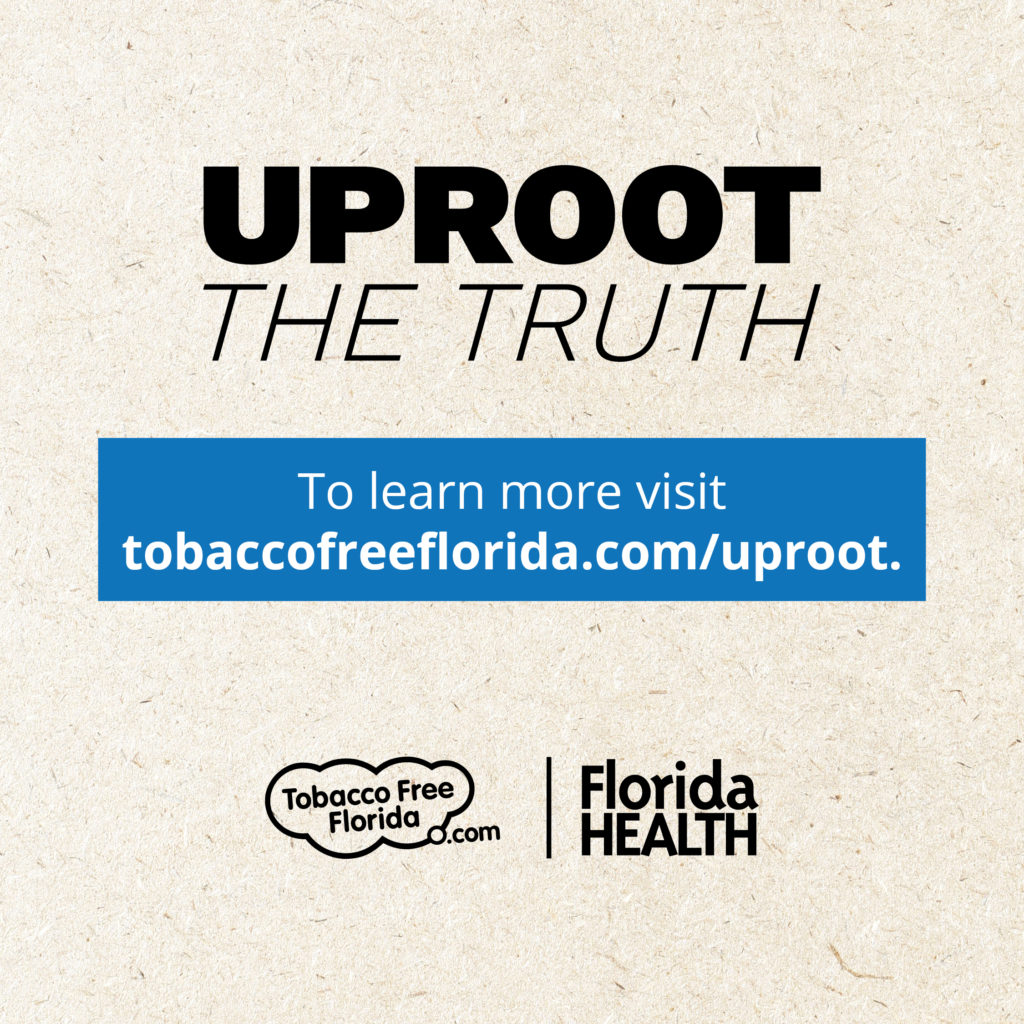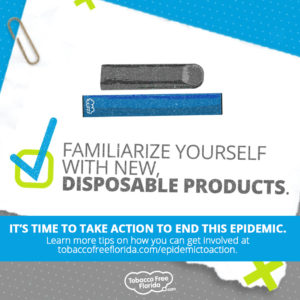About E-Cigarettes
Whether it is the dramatic increase of youth use or the potential of quitting smoking, many people want to learn more about e-cigarettes. To learn more about youth and e-cigarettes, visit: Youth and E-Cigarettes.
E-cigarettes are battery powered devices that heat e-liquid (usually containing nicotine, an addictive and dangerous drug)1 into an aerosol, which is then inhaled. The aerosol is sometimes mistakenly called “vapor,” but is not simply “water vapor.” While the standard term is “e-cigarettes,” these products are also known by other names, like “e-cigs,” “vapes,” “vape pens,” “mods,” or “tank systems.” They are also called by their brand names, like the commonly-known Juul. Using an e-cigarette can be referred to as “vaping” or “Juuling.”
E-Cigarettes and Your Health
It is important to know that e-cigarettes are not harmless. The long-term health effects of e-cigarettes are still unknown, but we do know that some of the ingredients in e-cigarette aerosol could be harmful to your lungs. E-cigarette aerosol can contain harmful substances like cancer-causing chemicals, propylene glycol, diacetyl, and heavy metals such as nickel, tin, and lead.2,3,4 Using e-cigarettes can also increase your odds of developing respiratory disease by 95%.5,6
Types of E-Cigarettes
There have been many forms of e-cigarettes since they first launched on the market. The most popular e-cigarette brand today is Juul,7 a device shaped like a USB flash drive – which makes it easy to conceal. Juul delivers high levels of nicotine.8,9,10 Juul’s nicotine liquid refills are called “JUULpods,” which contain as much nicotine as a pack of cigarettes.11
However, youth are rapidly switching from Juul to flavored disposable e-cigarettes. Some of the most popular brands include Puff Bars, Stig, Smok, POSH and HQD.12
1st Generation E-Cigarettes
- Called “disposable e-cigarettes” or “cigalikes”
- Designed to be used once and then thrown away
- Mimic the look and feel of traditional cigarettes
2nd Generation E-Cigarettes
- Called “pens”
- Rechargeable, designed to be used multiple times
- E-liquid comes in prefilled or refillable cartridges
3rd Generation E-Cigarettes
- Called “tanks” or “mods”
- Rechargeable, designed to be used multiple times
- Modifiable and customizable
4th Generation E-Cigarettes
- Called “pod mods”
- “Pods” or “cartridges” hold the e-liquid, and can be prefilled or refillable.
- Typically use nicotine salts, rather than freebase nicotine
- Often contain higher amounts of nicotine than previous generations
Quitting and E-Cigarettes
According to the U.S. Surgeon General, there is not enough evidence to say that e-cigarettes can help people quit.13 E-cigarettes are not currently approved by the FDA as a quit smoking aid. FDA approval ensures that the products are safe and effective and that their benefits outweigh any known associated risks.
“…the potential benefit of e-cigarettes for cessation among adult smokers cannot come at the expense of escalating rates of use of these products by youth.”
Tobacco Free Florida Can Help You Quit
Creating a quit plan and using proven-effective resources, like Tobacco Free Florida, can significantly increase your chances of quitting smoking for good.14 Tobacco Free Florida offers free tools and services to help people quit nicotine, including e-cigarettes.

Youth aged 11-13 can access Phone Quit, and Youth aged 13-17 can access Phone Quit and Web Quit.
Learn more about Tobacco Free Florida’s free and proven-effective resources here.
Infographic
The Generations of E-Cigarettes
1 “Adult Smoking Cessation-The Use of E-Cigarettes.” Centers for Disease Control and Prevention, Centers for Disease Control and Prevention, 23 Jan. 2020, https://www.cdc.gov/tobacco/data_statistics/sgr/2020-smoking-cessation/fact-sheets/adult-smoking-cessation-e-cigarettes-use/index.html
2 Wieslander G, Norb€ack D, Lindgren T. Experimental exposure to pro-pylene glycol mist in aviation emergency training: acute ocular and respiratory effects. Occup Environ Med. 2001;58(10):649–655. https://doi.org/10.1136/oem.58.10.649. [Accessed January 28, 2020].
3 Farsalinos KE, Kistler KA, Gillman G, Voudris V. Evaluation of elec-tronic cigarette liquids and aerosol for the presence of selected inhala-tion toxins. Nicotine Tob Res. 2015;17(2):168–174. https://doi.org/10.1093/ntr/ntu176. [Accessed January 28, 2020].
4 US Department of Health and Human Services. E-cigarette Use Among Youth and Young Adults: A Report of the Surgeon General. Atlanta, GA: US Department of Health and Human Services, CDC; 2016. Accessed January 28, 2020.
5 Association of E-Cigarette Use With Respiratory Disease Among Adults: A Longitudinal Analysis. Bhatta, Dharma N. et al. American Journal of Preventive Medicine, Volume 58, Issue 2, 182 – 190. Accessed January 28, 2020.
6 Association of E-Cigarette Use With Respiratory Disease Among Adults: A Longitudinal Analysis. Bhatta, Dharma N. et al. American Journal of Preventive Medicine, Volume 58, Issue 2, 182 – 190. Accessed January 29, 2020.
7 Craver, Richard. “Juul ends 2018 with 76 percent market share.” Winston-Salem Journal. 8 Jan. 2019. https://www.journalnow.com/business/juul-ends-with-percent-market-share/article_6f50f427-19ec-50be-8b0c-d3df18d08759.html
8 CDC Newsroom Releases. “Sales of JUUL e-cigarettes skyrocket, posing danger to youth.” Centers for Disease Control and Prevention (CDC). 2 Oct. 2018. https://www.cdc.gov/media/releases/2018/p1002-e-Cigarettes-sales-danger-youth.html
9 Truth Initiative. “Nearly 1 in 5 youth say they have seen JUUL used in school.” 23 May 2018. https://truthinitiative.org/news/nearly-1-5-youth-say-they-have-seen-juul-used-school
10 Zernike, Kate. “‘I Can’t Stop’: Schools Struggle With Vaping Explosion.” The New York Times. 2 April 2018. https://www.nytimes.com/2018/04/02/health/vaping-ecigarettes-addiction-teen.html
11 Centers for Disease Control and Prevention (CDC). “E-cigarettes Shaped Like USB Flash Drives: Information for Parents, Educators and Health Care Providers.” CDC Office on Smoking and Health, National Center for Chronic Disease Prevention and Health Promotion. 18 Oct. 2018. https://www.cdc.gov/tobacco/basic_information/e-cigarettes/factsheet/index.html (Accessed 11 March 2019)
12 What are Puff Bars? Truth Initiative. February 14, 2020. https://truthinitiative.org/research-resources/emerging-tobacco-products/what-are-puff-bars. Accessed February 14, 2020.
13 U.S. Department of Health and Human Services. Smoking Cessation. A Report of the Surgeon General. Atlanta, GA: U.S. Department of Health and Human Services, Centers for Disease Control and Prevention, National Center for Chronic Disease Prevention and Health Promotion, Office on Smoking and Health, 2020. Accessed January 30, 2020.
14 US Public Health Service. Treating tobacco use and dependence: 2008 update. Clinical practice guideline. Rockville, MD: US Department of Health and Human Services, US Public Health Service; 2008. https://www.ahrq.gov/professionals/clinicians-providers/guidelines-recommendations/tobacco/index.html.




















